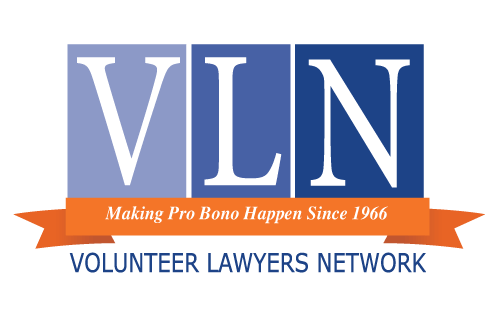Immigration Volunteer Resources
The Volunteer Lawyers Network (VLN) seeks to ensure family unity, safety and stability as it provides legal help in immigration matters. VLN needs the help of volunteer lawyers, law students, community members, and others to provide crucial immigration-related legal services to low-income immigrants and refugees in our Minnesota community.
VLN volunteers help to provide advice, a brief legal service, pro se assistance, full representation, and/or referral in a variety of immigration matters such as naturalization, asylum, DACA, Temporary Protected Status (TPS), Adjustment of Status, family-based petitions, SIJS, SIV (Afghan), U Visa, EADs, and other types of cases.
Services are provided by phone or in-person, depending on the type of case.
There are also opportunities to mentor and train other legal professionals and help to create educational and pro se materials.



Requirements for Volunteering
Phone Advice – provide brief advice by phone (e.g. remotely from your office) to clients with pre-arranged appointment
Time Commitment and Qualifications
- 1-2 hours per shift
- Shifts may be once per month, once every two weeks or once a week
- Special need for Spanish speaking attorneys for the Spanish legal phone line (but we also use interpreters)
- 2+ years immigration experience
Location and Target Audience
- At your own office or private space
- Persons throughout Minnesota who have limited access to legal help (this service is particularly helpful for people in Greater MN or persons in sanctuary-type situations)
Legal Clinics (in-person legal advice and brief service) – through on-site legal clinics located throughout Twin Cities
Time Commitment and Qualifications
- 2+ hour shifts on-site at a legal clinic
- Shifts may be once per month, once every two weeks or once a week
- Special need for Spanish speakers (but not a requirement).
- 2+ years immigration experience
Location and Target Audience
- In-person at site (sites located in South and North Mpls, northern suburbs, St. Paul).
- Persons who walk-in or have a pre-arranged appointment.
- Special need for 1-2 immigration attorneys to help staff monthly legal clinic for primarily Somali clients at the Brian Coyle Legal Clinic
- Special need for Family Unity Clinic doing family-based advice and brief service (partnership with ILCM)
Pop-Up Legal Clinics – travel to locations in Greater Minnesota to provide on-site legal advice and services
Time Commitment and Qualifications
- 2-10 hour commitment per visit
- Special need for Spanish speaking attorneys
- Includes Family Emergency Preparedness and pro se help
- 2+ years immigration experience
Location and Target Audience
- In-person at site (sites in Twin Cities, Greater MN).
- Persons who walk-in or have a pre-arranged appointment.
Full Representation – assumes legal representation for pre-screened U-Visa, DACA renewals, TPS, Naturalization cases, AOS (Afghan), family-based, humanitarian parole, etc.
Time Commitment and Qualifications
- 8-50 hours
- May require long-term commitment in certain types of cases
- 2+ years immigration experience certain cases
- No experience needed for cases in which VLN provides training like naturalization cases
Location and Target Audience
- Mostly at your office or private space
- Some activities may happen at VLN or another site
Mentor Attorney – provide mentorship in naturalization & other matters to volunteer lawyers without prior experience but trained
Time Commitment and Qualifications
- 2-10 hours
- Mentorship provided as needed and according to mutually agreed upon level of contact, etc.
Location and Target Audience
- Mostly from your office or a mutually agreed upon meeting place/mode
Trainer Attorneys – provide training in naturalization and other immigration matters to new volunteers
Time Commitment and Qualifications
- 2-10 hours per year
- Particular expertise in naturalization and other related immigration matters
Location and Target Audience
- At a training site in the Twin Cities and if the need arises in Greater Minnesota
Workshops / Presentations – done at different sites in Twin Cities and throughout Minnesota
Time Commitment and Qualifications
- 1-2 hours per presentation
- Requires travel to and from site
- Present to group on legal subject
- Possibly meet individually with some attendees for brief advice and referral after the presentation
Location and Target Audience
- Immigration (presentations conducted in Twin Cities and Statewide.
- Immigration screening and advice, KYR, and Family Emergency Preparedness audiences
- Schools, social service providers, faith communities, etc.
Special Juvenile Immigrant Panel – provide one-time consultation for prospective custodian regarding immigration-related risks
Time Commitment and Qualifications
- 1-2 hours per consultation (includes one-on-one consultation and follow-up conversation with family law attorney
- Spanish language is helpful but not required
Location and Target Audience
- At your own office or private space
Educational and Pro Se Materials Development – help to draft educational fact sheets and pro se materials for clients.
Time Commitment and Qualifications
- 5-20 hours
Location and Target Audience
- At your own office or private space. By phone, virtually or in person when meeting with VLN.
Trainings and Frequently Used Resources
To help you with your volunteer experience, please contact VLN’s Immigrant Legal Services general email at immigration@vlnmn.org or your staff contact for the following:
- Templates
- Links to important resources
- VLN client-specific information and placement documents
- Placement with a mentor
- Case closing information

